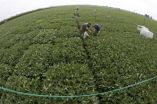(Press-News.org) Boston, MA — At the elevated levels of atmospheric CO2 anticipated by around 2050, crops that provide a large share of the global population with most of their dietary zinc and iron will have significantly reduced concentrations of those nutrients, according to a new study led by Harvard School of Public Health (HSPH). Given that an estimated two billion people suffer from zinc and iron deficiencies, resulting in a loss of 63 million life years annually from malnutrition, the reduction in these nutrients represents the most significant health threat ever shown to be associated with climate change.
"This study is the first to resolve the question of whether rising CO2 concentrations—which have been increasing steadily since the Industrial Revolution—threaten human nutrition," said Samuel Myers, research scientist in the Department of Environmental Health at HSPH and the study's lead author.
The study appears online May 7, 2014 in Nature.
Some previous studies of crops grown in greenhouses and chambers at elevated CO2 had found nutrient reductions, but those studies were criticized for using artificial growing conditions. Experiments using free air carbon dioxide enrichment (FACE) technology became the gold standard as FACE allowed plants to be grown in open fields at elevated levels of CO2, but those prior studies had small sample sizes and have been inconclusive.
The researchers analyzed data involving 41 cultivars (genotypes) of grains and legumes from the C3 and C4 functional groups (plants that use C3 and C4 carbon fixation) from seven different FACE locations in Japan, Australia, and the United States. The level of CO2 across all seven sites was in the range of 546-586 parts per million (ppm). They tested the nutrient concentrations of the edible portions of wheat and rice (C3 grains), maize and sorghum (C4 grains) and soybeans and field peas (C3 legumes).
The results showed a significant decrease in the concentrations of zinc, iron, and protein in C3 grains. For example, zinc, iron, and protein concentrations in wheat grains grown at the FACE sites were reduced by 9.3%, 5.1%, and 6.3% respectively, compared with wheat grown at ambient CO2. Zinc and iron were also significantly reduced in legumes; protein was not.
The finding that C3 grains and legumes lost iron and zinc at elevated CO2 is significant. Myers and his colleagues estimate that 2-3 billion people around the world receive 70% or more of their dietary zinc and/or iron from C3 crops, particularly in the developing world, where zinc and iron deficiency is already a major health concern.
C4 crops appeared to be less affected by higher CO2, which is consistent with underlying plant physiology, as C4 plants concentrate CO2 inside the cell for photosynthesis so they might be expected to be less sensitive to extracellular changes in CO2 concentration.
The researchers were surprised to find that zinc and iron varied substantially across cultivars of rice. That finding suggests that there could be an opportunity to breed reduced sensitivity to the effect of elevated CO2 into crop cultivars in the future.
In addition to efforts to reduce CO2 emissions, breeding cultivars with reduced sensitivity to CO2, biofortification of crops with iron and zinc, and nutritional supplementation for populations most impacted could all play a role in reducing the human health impacts of these changes, said Myers. "Humanity is conducting a global experiment by rapidly altering the environmental conditions on the only habitable planet we know. As this experiment unfolds, there will undoubtedly be many surprises. Finding out that rising CO2 threatens human nutrition is one such surprise," he said.
INFORMATION:
Other HSPH authors include Antonella Zanobetti, Itail Kloog, and Joel Schwartz.
Support for the study was provided by the Bill & Melinda Gates Foundation; the Winslow Foundation; the Department of Agriculture (Australia); the International Plant Nutrition Institute (Australia); the Grains Research and Development Corporation (Australia); the Ministry of Agriculture, Forestry and Fisheries (Japan), the National Science Foundation (NSF IOS-08-18435); USDA NIFA 2008-35100-044459; research at SoyFACE was supported by the U.S. Department of Agriculture Agricultural Research Service; Illinois Council for Food and Agricultural Research (CFAR); U.S. Department of Energy's Office of Science (BER) Midwestern Regional Center of the National Institute for Climatic Change Research at Michigan Technological University, under Award Number DEFC02-06ER64158; and the National Research Initiative of Agriculture and Food Research Initiative Competitive Grants Program Grant no. 2010-65114-20343 from the USDA National Institute of Food and Agriculture. Early stages of this work received support from Harvard Catalyst │ The Harvard Clinical and Translational Science Center (National Center for Research Resources and the National Center for Advancing Translational Sciences, National Institutes of Health Award 8UL1TR000170-05).
"Increasing CO2 threatens human nutrition," Samuel S. Myers, Antonella Zanobetti, Itai Kloog, Peter Huybers, Andrew D. B. Leakey, Arnold Bloom, Eli Carlisle, Lee H. Dietterich, Glenn Fitzgerald, Toshihiro Hasegawa, N. Michele Holbrook, Randall L. Nelson, Michael J. Ottman, Victor Raboy, Hidemitsu Sakai, Karla A. Sartor, Joel Schwartz, Saman Seneweera, Michael Tausz, Yasuhiro Usui, Nature, May 7, 2014, DOI: 10.1038/nature13179
Rising CO2 poses significant threat to human nutrition
2014-05-07
ELSE PRESS RELEASES FROM THIS DATE:
Study urges caution in stem cell clinical trials for heart attack patients
2014-05-07
CINCINNATI – A new study in Nature challenges research data that form the scientific basis of clinical trials in which heart attack patients are injected with stem cells to try and regenerate damaged heart tissue.
Researchers at Cincinnati Children's Hospital Medical Center and the Howard Hughes Medical Institute (HHMI), report May 7 that cardiac stem cells used in ongoing clinical trials – which express a protein marker called c-kit – do not regenerate contractile heart muscle cells at high enough rates to justify their use for treatment.
Including collaboration from ...
Greenland melting due equally to global warming, natural variations
2014-05-07
The rapid melting of Greenland glaciers is captured in the documentary "Chasing Ice." The retreat of the ice edge from one year to the next sends more water into the sea.
Now University of Washington atmospheric scientists have estimated that up to half of the recent warming in Greenland and surrounding areas may be due to climate variations that originate in the tropical Pacific and are not connected with the overall warming of the planet. Still, at least half the warming remains attributable to global warming caused by rising carbon dioxide emissions. The paper is ...
As CO2 levels rise, some crop nutrients will fall
2014-05-07
CHAMPAIGN, Ill. — Researchers have some bad news for future farmers and eaters: As carbon dioxide levels rise this century, some grains and legumes will become significantly less nutritious than they are today.
The new findings are reported in the journal Nature. Eight institutions, from Australia, Israel, Japan and the United States, contributed to the analysis.
The researchers looked at multiple varieties of wheat, rice, field peas, soybeans, maize and sorghum grown in fields with atmospheric carbon dioxide levels like those expected in the middle of this century. ...
Scientists create first living organism that transmits added letters in DNA 'alphabet'
2014-05-07
LA JOLLA, CA—May 7, 2014—Scientists at The Scripps Research Institute (TSRI) have engineered a bacterium whose genetic material includes an added pair of DNA "letters," or bases, not found in nature. The cells of this unique bacterium can replicate the unnatural DNA bases more or less normally, for as long as the molecular building blocks are supplied.
"Life on Earth in all its diversity is encoded by only two pairs of DNA bases, A-T and C-G, and what we've made is an organism that stably contains those two plus a third, unnatural pair of bases," said TSRI Associate Professor ...
Vascular simulation research reveals new mechanism that switches in disease
2014-05-07
BOSTON -- Blood vessel formation is critical to life and its manipulation is instrumental to a number of diseases. For more than 40 years, investigations into the structure and function of endothelial cells lining the blood vessels have revealed a complex tissue with complex functions, demonstrating that endothelial cells participate in all aspects of vascular homeostasis and pathological processes.
Today, important revelations regarding endothelial cell behavior are emerging from vascular simulation research, a blossoming interdisciplinary field that makes use of novel ...
Airborne measurements confirm leaks from oil and gas operations
2014-05-07
During two days of intensive airborne measurements, oil and gas operations in Colorado's Front Range leaked nearly three times as much methane, a greenhouse gas, as predicted based on inventory estimates, and seven times as much benzene, a regulated air toxic. Emissions of other chemicals that contribute to summertime ozone pollution were about twice as high as estimates, according to the new paper, accepted for publication in the American Geophysical Union's Journal of Geophysical Research: Atmospheres.
"These discrepancies are substantial," said lead author Gabrielle ...
Astronomers create first realistic virtual universe
2014-05-07
Move over, Matrix - astronomers have done you one better. They have created the first realistic virtual universe using a computer simulation called "Illustris." Illustris can recreate 13 billion years of cosmic evolution in a cube 350 million light-years on a side with unprecedented resolution.
"Until now, no single simulation was able to reproduce the universe on both large and small scales simultaneously," says lead author Mark Vogelsberger (MIT/Harvard-Smithsonian Center for Astrophysics), who conducted the work in collaboration with researchers at several institutions, ...
Brain noise found to nurture synapses
2014-05-07
NEW YORK, NY (May 7, 2014) — A study has shown that a long-overlooked form of neuron-to-neuron communication called miniature neurotransmission plays an essential role in the development of synapses, the regions where nerve impulses are transmitted and received. The findings, made in fruit flies, raise the possibility that abnormalities in miniature neurotransmission may contribute to neurodevelopmental diseases. The findings, by researchers at Columbia University Medical Center (CUMC), were published today in the online edition of the journal Neuron.
The primary way ...
Native algae species to blame for 'rock snot' blooms in rivers worldwide
2014-05-07
VIDEO:
The recent appearance of the freshwater algae known as "rock snot " on river bottoms worldwide is caused by a native species responding to changing environmental conditions rather than by accidental...
Click here for more information.
The recent blooms of the freshwater algae known as "rock snot" on river bottoms worldwide are caused by a native species responding to changing environmental conditions rather than by accidental introductions by fishermen or the ...
Early depression, anger may taint love life even 20 years later, study shows
2014-05-07
A University of Alberta study is helping crack the code to happiness by exploring the long reach of depression and anger over more than two decades.
The study, published recently in the Journal of Family Psychology, followed 341 people for 25 years, and found that negative emotions they may have suffered as young adults can have a lasting grip on their couple relationships, well into middle age.
The fact that depression and anger experienced during the teen years clung to people, even through major life events such as child-rearing, marriages and careers was surprising, ...




